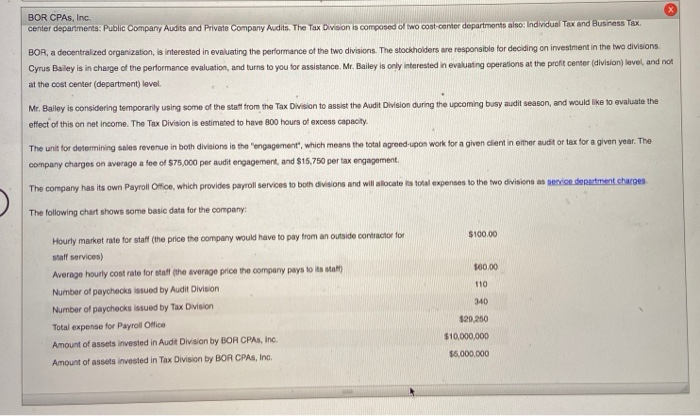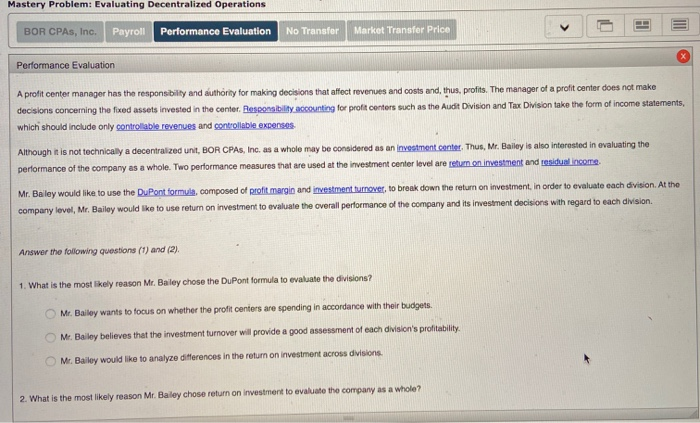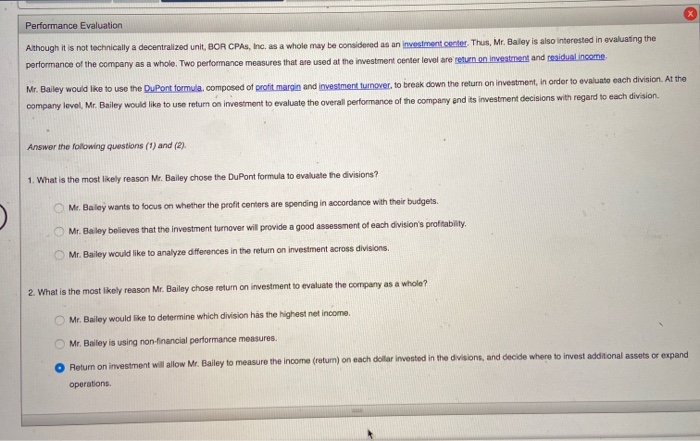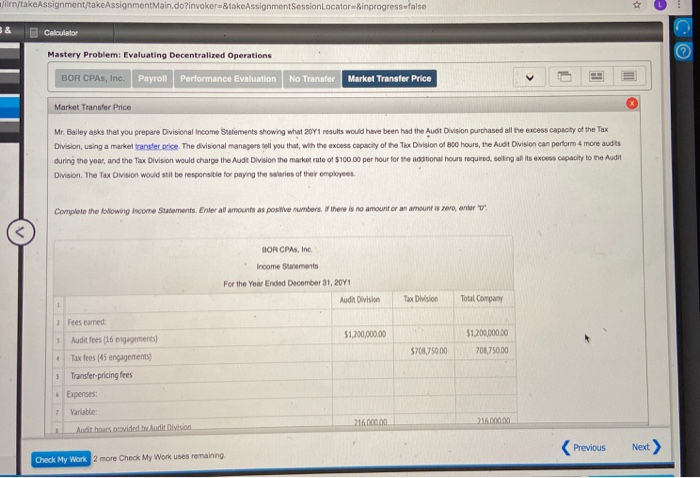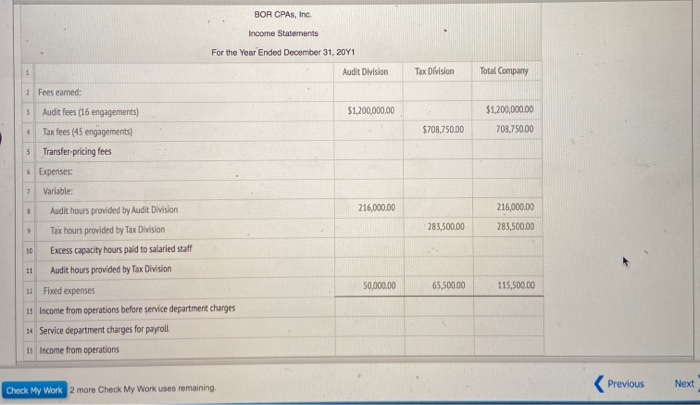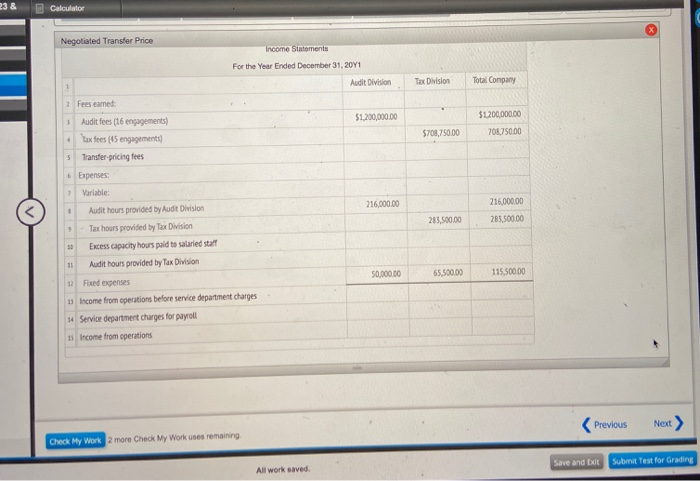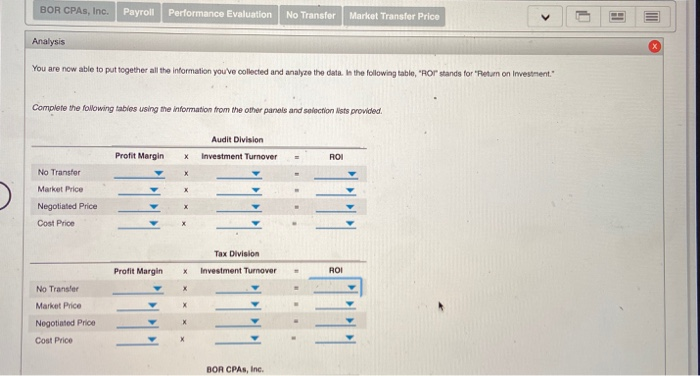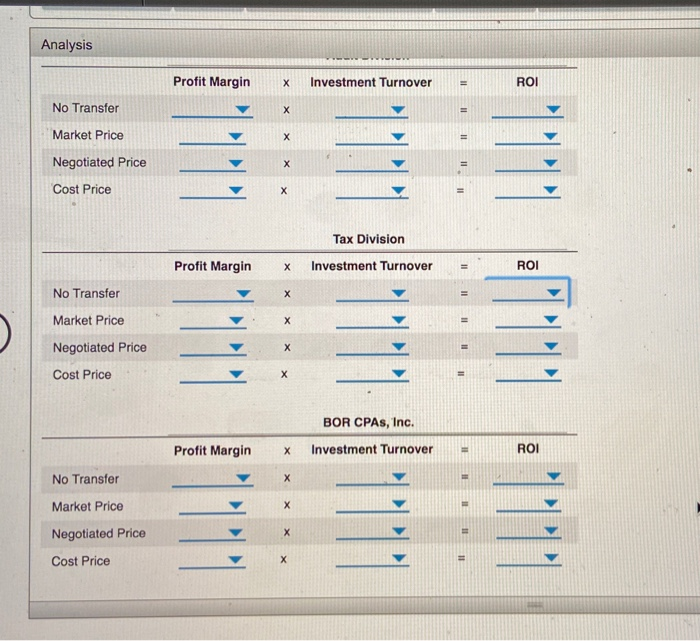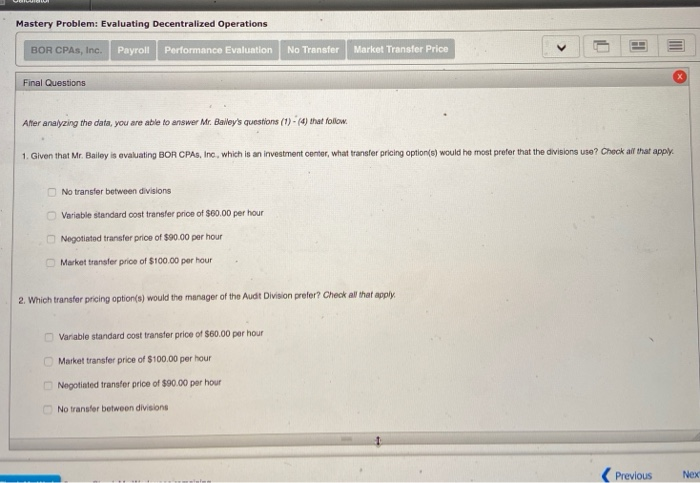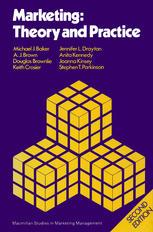BOR CPAs, Inc. BOR CPAs, Inc. is a closely held corporation owned by three stockholders who used the initials of their last names to form the corporation's name: Cyrus Balley, John Ogden, and Samuel Rogers. The firm's Certified Public Accountants (CPA) perfom audits of both public companies and privately owned companies. BOR'S CPAS also provide tax services to bom individuals and businesses The corporation is divided into two profit centers: the Audit Division and the Tax Division. Each division is composed of two costanters. The Audit Division is composed of two cost center departments: Public Company Audits and Private Company Audits. The Tax Division is composed of two cost-center departments also: Individual Tax and Business Tax BOR, a decentralized organization is interested in evaluating the performance of the two divisions. The stockholders are responsible for deciding on investment in the two divisions. Cyrus Baley is in charge of the performance evaluation, and turns to you for assistance. Mr. Bailey is only interested in evaluating operations at the profit center (division) level, and not at the cost center (department level. Mr. Bailey is considering temporarily using some of the staff from the Tax Division to assist the Audit Division during the upcoming busy audit season, and would like to evaluate the effect of this on net income. The Tax Division is estimated to have 800 hours of excess capacity The unit for determining sales revenue in both division is the engagement, which means the total agreed upon work for a given client in either auditor tax for a given you. The company charges on average a fee of $75,000 per audit engagement and $15.750 per tax engagement, The company has its own Payroll Office, which provides payroll services to both divisions and will allocate is total expenses to the two divisions as service department charges The following chart shows some basic data for the company $100.00 Hourly market rate for sta (the price the company would have to pay from an outside contractor for staff services) Average hourly cost rate for staff (the average price the company pays to its 500.00 no BOR CPAS, Inc. center departments: Public Company Audits and Private Company Audits. The Tax Division is composed of two cost center departments also: Individual Tax and Business Tax BOR, a decentralized organization, is interested in evaluating the performance of the two divisions. The stockholders are responsible for deciding on investment in the lwa divisions. Cyrus Bailey is in charge of the performance evaluation, and turns to you for assistance. Mr. Bailey is only interested in evaluating operations at the profit center (division) level, and not at the cost center (department) level Mr. Bailey is considering temporarily using some of the staff from the Tax Division to assist the Audit Division during the upcoming busy audit season, and would like to evaluate the effect of this on net income. The Tax Division is estimated to have 800 hours of excess capacity. The unit for determining sales revenue in both division is the engagement, which means the total agreed upon work for a given client in either audit or tax for a given year. The company charges on average a fee of $75,000 per audit engagement, and $15.750 per tax engagement The company has its own Payroll Office, which provides payroll services to both divisions and will allocate is total expenses to the two divisions asso r tment charges The following chart shows some basic data for the company $100.00 560.00 110 Hourly market rate for staff (the price the company would have to pay from an outside contractor for staff services) Average hourly cost rate for staff (the average price the company pays to its staff) Number of paychecks issued by Audit Division Number of paychecks issued by Tax Division Total expense for Payroll Office Amount of assets invested in Audit Division by BOR CPAS, Inc. Amount of assets invested in Tax Division by BOR CPA, Ing. 340 $20.250 $10,000,000 $5.000.000 Payroll Mr. Bailey would like you to start by analyzing the Payroll Office expenses, and allocating the the activity base for the allocation expenses to each division. He has decided to use the number of payroll checks as FW in the following blanks, alocating the total expense for the Payroll Office to each of the two divisions Payrol Charge Rates per payroll check Allocated Service Department Charges Division Audit Division Tax Division Check My Work 2 more Check My Work uses remaining. Previous Next > All work saved Save and Exit Submit Test for Gradini MUUT PIUUIUM EVAaung Decentralized Operations BOR CPAs, Inc. Payroll Performance Evaluation No Transfer Market Transfer Price Performance Evaluation A profit center manager has the responsibility and authority for making decisions that affect revenues and costs and, thus, profits. The manager of a profit center does not make decisions concerning the forced assets invested in the center Responsibility accounting for profit centers such as the Audit Division and Tax Division take the form of income statements, which should include only controllable revenues and controllable expenses Although it is not technically a decentralized unit, BOR CPAs, Inc. as a whole may be considered as an investment center. Thus, Mr. Bailey is also interested in evaluating the performance of the company as a whole. Two performance measures that are used at the investment center level are return on investment and residual income Mr. Baley would like to use the DuPont formula, composed of profit margin and investment turnover, to break down the return on investment in order to evaluate each division. At the company level, Mr. Bailey would like to use return on investment to evaluate the overall performance of the company and its investment decisions with regard to each division. Answer the following questions (1) and (2) 1. What is the most likely reason Mr. Baley chose the DuPont formula to evaluate the divisions? Mr. Bailey wants to focus on whether the profit centers are spending in accordance with their budgets. M. Bailey believes that the investment turnover will provide a good assessment of each division's profitability M. Balloy would like to analyze differences in the return on investment across divisions 2. What is the most likely reason Mr. Baley chose return on investment to evaluate the company as a whole? Performance Evaluation Although it is not technically a decentralized unit, BOR CPAS, ina, as a whole may be considered as an investment ter. Thus, Mr. Baley is also interested in evaluating the performance of the company as a whole. Two performance measures that are used at the investment center level are return on investment and realdual income Mr. Bailey would like to use the DuPont formula, composed of profit margin and investment turnover, to break down the return on investment, in order to evaluate each division. At the company level, Mr. Bailey would like to use return on investment to evaluate the overall performance of the company and its investment decisions with regard to each division Answer the following questions (1) and (2) 1. What is the most likely reason Mr. Bailey chose the DuPont formula to evaluate the divisions? Mr. Baley wants to focus on whether the profit centers are spending in accordance with their budgets Mr. Baley believes that the investment turnover will provide a good assessment of each division's proftability Mr. Bailey would like to analyze differences in the return on investment across divisions 2. What is the most likely reason Mr. Bailey chose return on investment to evaluate the company as a whole? Mr. Bailey would like to determine which division has the highest net income. Mr Bailey is using non-financial performance measures. Return on investment will allow M. Bally to measure the income (return) on each dollar invested in the divisions, and decide where to invest additional asset or expand operations. BOR CPAs, Inc. Payroll Performance Evaluation No Transfer Market Transfer Price No Transfer Mr. Baley has prepared the following divisional income statement for you to review, assuming no transfer of excess capacity hours occurs. He has also included the total amounts for BOR CPAS, Inc. in the rightmost column Complete the following income Statements with your data from the Payrol panel Enerall amount as positive numbers. BOR CPAs, Inc Income Statements For the Year Ended December 31, 2011 Audit Division Tax Division Total Company ? Fees eamed $900,000.00 Audit fees (12 engagements) Taxfees (45 engagements) Transfer pricing fees 5900,000.00 700.750.00 $700.750.00 0.00 Expenses 1 Variable Audit hours provided by Audit Division 216,000.00 216.000.00 283,500.00 Tax hours provided by Tax Division 281500.00 Check My Work 2 more Check My Work uses remaining All work saved Save and Ext Submit Test for Grading No Transfer BOR CPAS, Inc. Income Statements For the Year Ended December 31, 20Y1 Audit Division > Fees earned $900,000.00 0000 $708,750.00 708,750.00 216,000.00 Audit fees (12 engagements) Tax fees (45 engagements) Transfer-pricing fees Expenses: Variable: Audit hours provided by Audit Division Tax hours provided by Tax Division 10 Excess capacity hours paid to salaried staff 11 Audit hours provided by Tax Division 12 Fixed expenses 15 Income from operations before service department charges 14 Service department charges for payroll 15 Income from operations 4800000 283,500.00 48,000.00 0.00 65,500.00 $311,750,00 50,000.00 $634000.00 115,500.00 $948, Check My Work 2 more Check My Work uses remaining. All work saved. Save and Exit r/takeAssignment/take Assignment Main.do?invokeretakeAssignmentSessionLocatorinprogress-false C & Calor Mastery Problemi Evaluating Decentralized Operations BOR CPAS, Inc. Payroll Performance Evaluation No Transfer Market Transfer Price Market Transfer Price Mr. Bailey asks that you prepare Divisional Income Statements showing what 20Y1 results would have been had the Audit Division purchased alle capacity of the Tax Division, using a market rasfericeThe divisional managers tell you that with the excess capacity of the Tax Division of 800 hours, the Audit Division can perform & more audits during the year, and the Tax Division would change the Audit Division the market rate of $100.00 per hour for the additional hours required, selling all its capacity to the Audit Division. The Tax Division would still be responsible for paying the series of their employees Complete the following income Statements. Enter all amounts as positive ubers. there is no amount or an amount is 70, ante BOR CPAs, Inc Income Stements For the Year Ended December 31, 2011 Audit Division Tax Division Total Company Feesamed $1,200,000.00 $1.200,000.00 708,75000 5700.750.00 Audit fees (16 engagements) Tax fees (45 engagements Transfer pricing fees 2500 Check My Work 2 more Check My Work uses remaining BOR CPAS, Inc. Income Statements For the Year Ended December 31, 20Y1 Audit Division Tax Division Total Company $1,200,000.00 Fees earned: Audit fees (16 engagements) Tax fees (45 engagements) Transfer pricing fees $1,200,000.00 708,750.00 $708,750.00 6 Expenses: Variable Audit hours provided by Audit Division 216,000.00 216,000.00 Tax hours provided by Tax Division 283,500.00 283,500.00 10 Excess capacity hours paid to salaried staff 11 Audit hours provided by Tax Division 50,000.00 65,500.00 115,500.00 12 Fixed expenses 13 Income from operations before service department charges 14 Service department charges for payroll 15 Income from operations Check My Work 2 more Check My Work uses remaining, All work saved. Save and Exit Submit Test for Grading Negotiated Transfer Price Income Statements For the Year Ended December 31, 20Y1 Audit Division Tax Division Total Company Fees eamet $1,200,000.00 $1.200,000.00 Audit fees (16 engagements) Tux fees (45 engagements Transfer pricing fees 5708.750.00 205000 Expenses 1 Variable: 216,000.00 216.000.00 2800.00 283,500.00 Audit hours provided by Audit Division Tax hours provided by Division Excess capacity hours paid to salaried staff Audit hours provided by Tax Division 11 11 Fixed expenses 50,000.00 65,500.00 115.500.00 13 Income from operations before service department charges 14 Service department charges for payroll 15 Income from operations Check My Work 2 more Check My Work was remaining All work ved Save and Exit Submit Test for Grading Mastery Problem: Evaluating Decentralized Operations BOR CPAs, Inc. Payroll Performance Evaluation No Transfer Market Transfer Price Cost Transfer Price Mr. Bailey asks that you prepare Divisional Income Statements showing what 20Y1 results would have been had the Audit Division purchased all the excess capacity of the Tax Division, using a cost transfer price. The divisional managers tell you that with the excess capacity of the Tax Division of 800 hours, The Audit Division can perform & more audits during the year, and the Audit Division would pay the Tax Division's internal hourly rate of $60.00 per hour for the additional hours required, with the Tax Division selling all its excess capacity to the Audit Division. The Tax Division would still be responsible for paying the salaries of their employees Complete the following income Statements Enteral amounts as positive numbers, there is no amount or an amount is zero, entero BOR CPAs, Inc. Income Statements For the Year Ended December 31, 2041 Audit Division Tax Division Total Company 2 Fees eamed $1,200,000.00 $1,200,000.00 Audit fees (16 engagements) Tax fees (45 engagements) Transfer pricing fees $708.750.00 708.750.00 5 Check My Work 2 more Check My Work uses remaining BOR CPAs, Inc. Payroll Performance Evaluation No Transfer Market Transfer Price Analysis You are now able to put together all the information you've collected and analyze the data. In the following table, 'ROP stands for return on investment Complete the following tables using the information from the other parels and selection Nists provided Audit Division Profit Margin X Investment Turnover = ROI No Transfer Market Price Negotiated Price Cost Price Tax Division Profit Margin X Investment Turnover - No Transfer Market Price Negotiated Price Cost Price BOR CPAs, Inc. Analysis Profit Margin X Investment Turnover ROI No Transfer x Market Price x x Negotiated Price Cost Price x Tax Division Profit Margin X Investment Turnover ROI No Transfer x Market Price x Negotiated Price x Cost Price x BOR CPAs, Inc. Profit Margin X Investment Turnover ROI No Transfer Market Price Negotiated Price Cost Price Mastery Problem: Evaluating Decentralized Operations BOR CPAS, Inc. Payroll Performance Evaluation No Transfer Market Transfer Price Final Questions After anayzing the data, you are able to answer Mr. Bailey's questions (1) - (4) that follow 1. Given that Mr Bailey is evaluating BOR CPAS, Inc., which is an investment Center, what transfer pricing option(s) would he most prefer that the divisions uso? Check all that apply No transfer between divisions Variable standard cost transfer price of $60.00 per hour Negotiated transfer price of $90.00 per hour Market transfer price of $100.00 per hour 2. Which transfer pricing option(s) would the manager of the Audit Division prefer? Check all that apply. Variable standard cost transfer price of $60.00 per hour Market transfer price of $100.00 per hour Negotiated transfer price of $90.00 per hour No transfer between divisions Previous Nex Mastery Problem: Evaluating Decentralized Operations BOR CPAs, Inc. Payroll Performance Evaluation No Transfer Market Transfer Price Final Questions Notransfer between division 3. Which transfer pricing options) would be manager of the Tax Division prefer? Check all that apply Negotiated transfer price of $90.00 per hour No transfer between divisions Variable standard cost transfer price of $60.00 per hour Market transfer price of $100.00 per hour 4. Given the preferences of the managers of the Audit and Tax Divisions, and also considering the preferences of BOR CPA, Inc., what might be the decision that provides the best outcome for all levels and entities within the company? the divisional managers cannot come to an agreement, 's best to forge any transfers between divisions in order to reduce conflict within the compa The company should use the market transfer prio, since important for the divisions to operate under real market conditions Use the negotiated transfer price, so that each entity is better off than it would be without any transfers between division The company should use the variable standard cor e price, because it would be unter for the Tax Division to make a protein desing with the Audt Division, since they're in the same company Check My Work 2 more Check My Work uses remaining,

